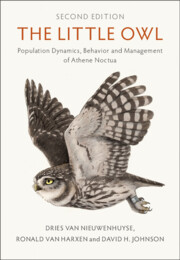
-
Select format
-
- Publisher:
- Cambridge University Press
- Publication date:
- September 2023
- October 2023
- ISBN:
- 9781009103725
- 9781009100151
- Dimensions:
- (244 x 170 mm)
- Weight & Pages:
- 1.34kg, 539 Pages
- Dimensions:
- Weight & Pages:
- Subjects:
- Animal Behaviour, Life Sciences, Ecology and Conservation
You may already have access via personal or institutional login- Subjects:
- Animal Behaviour, Life Sciences, Ecology and Conservation
Book description
The basic biology of owls is poorly understood compared to that of other bird species. The Little Owl, Athene noctua, is one of the best models for biological and conservation research. Though widespread across Europe, Asia and North Africa, populations of the Little Owl are now in decline, making studies of its behavior and ecology all the more important. This extensively revised and updated second edition features substantial new long-term data on population dynamics, behavioral observations and breeding biology of the Little Owl. The authors discuss its wide-ranging ecology, genetics, subspecies, and population status by country. In addition, they outline a research strategy and monitoring program. Exceptional illustrations of all fourteen subspecies cover embryonic and chick development, feather growth and moult, including high-quality drawings presenting concrete management suggestions. Whilst being an invaluable resource for academic researchers, its accessible and straightforward style will also appeal to amateur ornithologists and enthusiasts.
Reviews
‘Among the many fascinating titbits to be found in The Little Owl is a note on beak colour. Recent research shows that females with yellower beaks rear significantly larger nestlings than their duller billed counterparts: what is more, juveniles sporting the brightest beaks receive more food than siblings with drab-coloured or grey bills. But there is nothing dull or drab about this book. Highly recommended.’
Dan Eatherley Source: Ibis
Contents
Metrics
Altmetric attention score
Full text views
Full text views help Loading metrics...
Loading metrics...
* Views captured on Cambridge Core between #date#. This data will be updated every 24 hours.
Usage data cannot currently be displayed.
Accessibility standard: Unknown
Why this information is here
This section outlines the accessibility features of this content - including support for screen readers, full keyboard navigation and high-contrast display options. This may not be relevant for you.
Accessibility Information
Accessibility compliance for the PDF of this book is currently unknown and may be updated in the future.


